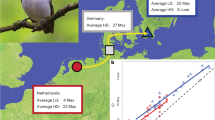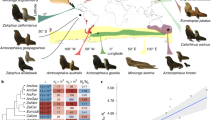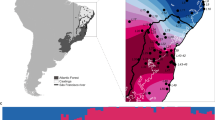Abstract
Understanding the capacity of natural populations to adapt to their local environment is a central topic in evolutionary biology. Phenotypic differences between populations may have a genetic basis, but showing that they reflect different adaptive optima requires the quantification of both gene flow and selection1,2,3. Good empirical data are rare4. Using data on a spatially structured island population of great tits (Parus major), we show here that a persistent difference in mean clutch size between two subpopulations only a few kilometres apart has a major genetic component. We also show that immigrants from outside the island carry genes for large clutches. But gene flow into one subpopulation is low, as a result of a low immigration rate together with strong selection against immigrant genes. This has allowed for adaptation to the island environment and the maintenance of small clutches. In the other area, however, higher gene flow prevents local adaptation and maintains larger clutches. We show that the observed small-scale genetic difference in clutch size is not due to divergent selection on the island, but to different levels of gene flow from outside the island. Our findings illustrate the large effect of immigration on the evolution of local adaptations and on genetic population structure.
This is a preview of subscription content, access via your institution
Access options
Subscribe to this journal
Receive 51 print issues and online access
$199.00 per year
only $3.90 per issue
Buy this article
- Purchase on Springer Link
- Instant access to full article PDF
Prices may be subject to local taxes which are calculated during checkout





Similar content being viewed by others
References
Slatkin, M. Gene flow in natural populations. Annu. Rev. Ecol. Syst. 16, 393–430 (1985)
Bohonak, A. J. Dispersal, gene flow, and population structure. Q. Rev. Biol. 74, 21–45 (1999)
Lenormand, T. Gene flow and the limits to natural selection. Trends Ecol. Evol. 17, 183–189 (2002)
Hendry, A. P., Day, T. & Taylor, E. B. Population mixing and the adaptive divergence of quantitative traits in discrete populations: A theoretical framework for empirical tests. Evolution 55, 459–466 (2001)
Ebert, D. et al. A selective advantage to immigrant genes in a Daphnia metapopulation. Science 295, 485–488 (2002)
Keller, L. F. et al. Immigration and the ephemerality of a natural population bottleneck: evidence from molecular markers. Proc. R. Soc. Lond. B 268, 1387–1394 (2001)
Ehrlich, P. R. & Raven, P. H. Differentiation of populations. Science 165, 1228–1232 (1969)
King, R. B. & Lawson, R. Color-pattern variation in Lake Erie water snakes: The role of gene flow. Evolution 49, 885–896 (1995)
Dhondt, A. A., Adriaensen, F., Matthysen, E. & Kempenaers, B. Nonadaptive clutch sizes in tits. Nature 348, 723–725 (1990)
Clobert, J., Perrins, C. M., McCleery, R. H. & Gosler, A. G. Survival rate in the great tit Parus major in relation to sex, age, and immigration status. J. Anim. Ecol. 57, 287–306 (1988)
McCleery, R. H. & Clobert, J. in Population Biology of Passerine Birds (eds Blondel, J., Gosler, A. G. & Clobert, J.) 423–440 (Springer, Berlin, 1990)
Marr, A. B., Keller, L. F. & Arcese, P. Heterosis and outbreeding depression in descendants of natural immigrants to an inbred population of song sparrows (Melospiza melodia). Evolution 56, 131–142 (2002)
Hendry, A. P., Taylor, E. B. & McPhail, J. D. Adaptive divergence and the balance between selection and gene flow: Lake and stream stickleback in the Misty system. Evolution 56, 1199–1216 (2002)
Stearns, S. C. & Sage, R. D. Maladaptation in a marginal population of the mosquito fish, Gambusia affinis . Evolution 34, 67–75 (1980)
Storfer, A. & Sih, A. Gene flow and ineffective antipredator behavior in a stream-breeding salamander. Evolution 52, 558–565 (1998)
Stanton, M. L. & Galen, C. Life on the edge: Adaptation versus environmentally mediated gene flow in the snow buttercup, Ranunculus adoneus . Am. Nat. 150, 143–178 (1997)
Lambrechts, M. M. & Dias, P. C. Differences in the onset of laying between island and mainland Mediterranean blue tits Parus caeruleus—Phenotypic plasticity or genetic differences. Ibis 135, 451–455 (1993)
Kingsolver, J. G. et al. The strength of phenotypic selection in natural populations. Am. Nat. 157, 245–261 (2001)
Krebs, J. R. & Davies, N. B. Behavioural Ecology: An Evolutionary Approach (Blackwell, Oxford, 1991)
Garant, D., Kruuk, L. E. B., Wilkin, T. A., McCleery, R. H. & Sheldon, B. C. Evolution driven by differential dispersal within a wild bird population. Nature doi:10.1038/nature03051 (this issue)
Verhulst, S. & Van Eck, H. M. Gene flow and immigration rate in an island population of great tits. J. Evol. Biol. 9, 771–782 (1996)
Van Noordwijk, A. J., Van Balen, J. H. & Scharloo, W. Genetic and environmental variation in clutch size of the great tit (Parus major). Neth. J. Zool. 31, 342–372 (1981)
Van Tienderen, P. H. & Van Noordwijk, A. J. Dispersal, kinship and inbreeding in an island population of the great tit. J. Evol. Biol. 1, 117–137 (1988)
Quinn, G. P. & Keough, M. J. Experimental Design and Data Analysis for Biologists (Cambridge Univ. Press, Cambridge, 2002)
SAS Institute Inc., SAS/STAT User's Guide (SAS Institute Inc., North Carolina, 1996)
Arnold, S. J. & Wade, M. J. On the measurement of natural and sexual selection: Theory. Evolution 38, 709–719 (1984)
Kruuk, L. E. B. Estimating genetic parameters in natural populations using the ‘animal model’. Phil. Trans. R. Soc. Lond. B 359, 873–890 (2004)
Lynch, M. & Walsh, B. Genetics and Analysis of Quantitative Traits (Sinauer Associates, Massachusetts, 1998)
Neumaier, A. & Groeneveld, E. Restricted maximum likelihood estimation of covariances in sparse linear models. Genet. Sel. Evol. 30, 3–26 (1998)
Groeneveld, E., Kovac, M., Wang, T. L. & Fernando, R. L. Computing algorithms in a general-purpose BLUP package for multivariate prediction and estimation. Arch. Anim. Breed. 35, 399–412 (1992)
Acknowledgements
This study would have been impossible without all those who collected data on Vlieland, and H. van Eck in particular. J. Visser maintained the database. L. Keller, K. Lessells, K. van Oers and M. Visser provided comments on earlier versions of the manuscript. E.P. is supported by ALW-NWO and a Marie-Curie fellowship.
Author information
Authors and Affiliations
Corresponding author
Ethics declarations
Competing interests
The authors declare that they have no competing financial interests.
Supplementary information
Supplementary Methods
Contains analyses that show that clutch size can be considered as a trait of the laying female. Also, information on how manipulated clutches were dealt with is provided. Finally, we give additional information on pedigree reconstruction and animal model analyses. (DOC 28 kb)
Rights and permissions
About this article
Cite this article
Postma, E., van Noordwijk, A. Gene flow maintains a large genetic difference in clutch size at a small spatial scale. Nature 433, 65–68 (2005). https://doi.org/10.1038/nature03083
Received:
Accepted:
Issue Date:
DOI: https://doi.org/10.1038/nature03083
This article is cited by
-
Genetic footprint of population diversity and genetic structure of Venturia inaequalis infecting apple (Malus × domestica Borkh.)
3 Biotech (2023)
-
The Importance of Intraspecific Variation for Niche Differentiation and Species Distribution Models: The Ecologically Diverse Frog Pleurodema thaul as Study Case
Evolutionary Biology (2020)
-
Female-biased dispersal and non-random gene flow of MC1R variants do not result in a migration load in barn owls
Heredity (2019)
-
The contrasting genetic patterns of two sympatric flying fox species from the Comoros and the implications for conservation
Conservation Genetics (2018)
-
Gene flow favours local adaptation under habitat choice in ciliate microcosms
Nature Ecology & Evolution (2017)
Comments
By submitting a comment you agree to abide by our Terms and Community Guidelines. If you find something abusive or that does not comply with our terms or guidelines please flag it as inappropriate.



